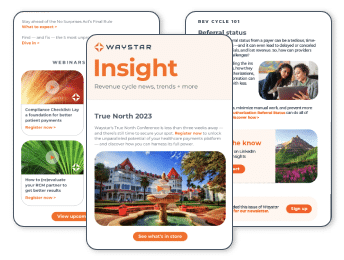How Testing, Telehealth + Elective Procedures Fluctuated from February to June
COVID-19 has forever changed healthcare, and its long-term impact will extend far beyond the effects visible today. At the same time, trends from the past several months can illuminate how this new landscape is taking shape and which changes are likely here to stay.
Waystar tapped into our database of 450K hospitals, health systems, and physician practices to see the implications of COVID on patients, providers, and payers. Below are the most prominent trends we’ve identified based on claims data from across our network.
Confirmed COVID-19 claims decline in June while testing rises
Claims for confirmed COVID diagnoses decreased by 3.5% from May to June following three months of aggressive growth. Diagnoses increased by 1,216% from February to March, 1,977% from March to April, and 73% from April to May. While this drop in claims is promising, it may sustain given recent COVID spikes in hotspots across the country; July claims data will be telling as cases continue to surge in states like Florida and California.
Even as cases continue to rise, COVID-related hospitalizations and daily deaths have been dropping from peak rates in April. The decline may be because younger patients who are testing positive are more able to recover at home, in isolation, rather than under the care of a physician or in the hospital.
Meanwhile, claims for COVID testing continued to rise in June. Claims have increased steadily over the past four months as testing has become more accessible, rising by 310% from March to April, 161% from April to May, and 54% from May to June. In comparison, testing increased by just 13% from February to March, when COVID began spreading in the US, and test inventory was low.
Hospice care and pharmacy claims remain high
The toll of COVID is also reflected by grim trends like increased hospice care claims during the crisis. Hospice claims increased in March and April, then decreased slightly but remained higher than average in May and June. During this period, pharmacy claims followed a similar pattern, while ambulance claims stayed relatively stable and even dropped below pre-COVID levels in May.
Patients turn to telehealth even as offices reopen
COVID has accelerated the adoption of virtual care (telehealth) and this trend is likely to become the new normal for many healthcare encounters. Telehealth claims increased by 603% from February to March as providers and patients across the nation began turning to virtual care following stay-at-home orders. This increased by another 369% from March to April.
While claims volumes have decreased about 25% from highs in April, telehealth continues to be an important mechanism for delivering care — and was 2,934% more prevalent in June than pre-COVID (in February 2020). Telehealth claims remained relatively steady in May and dipped slightly in June as more patients returned to in-person offices and facilities.
Forrester predicts that telehealth visits will exceed 1 billion this year, and claims data reinforces that virtual health is here to stay beyond the worst of the COVID crisis. Providers and patients alike are recognizing the benefits of telehealth and will likely continue to embrace this shift.
Providers adapt to keep revenue flowing
The surge in COVID testing and treatment and the dramatic rise of telehealth services have also impacted providers and payers from an administrative perspective. They’ve navigated this influx successfully, processing and reimbursing telehealth and COVID-related claims relatively quickly.
Claims for telehealth visits have been collected 40% faster, on average, than all other claims and 37% faster for those related to COVID. These claims are mostly ‘clean;’ 98.99% of telehealth claims and 97.92% of COVID claims have been free of errors and rejections.
These trends reinforce the idea that cash flow is more critical than ever for providers and hospitals. Revenue is scarce, and the future is uncertain; they must quickly process and collect on claims for the services that are in the highest demand (e.g., telehealth and COVID testing/treatment).
In-person visits rise in May and June following April lows
In-person care decreased in March and April as patients stayed home and increasingly turned to telehealth; visits to doctor’s offices decreased by 39% from March to April, while urgent care claims decreased by 47%. As restrictions lifted in May, in-person care began to increase again, with claims rising by 10% for offices and 20% for urgent care. In June, they grew by another 28% and 27%, respectively.
Inpatient facilities, in contrast, were not impacted by stay-at-home orders, which is reflected by a steady volume of claims from nursing, assisted living, and inpatient psychiatric providers.
Some common elective surgeries rebound in June
In June, claims for three types of elective procedures — plastic surgery, orthopedic, and cosmetic surgery — all reached or surpassed their volume pre-COVID. We looked at these claims as a proxy for elective surgeries, with the caveat that the rebound in these procedures may not represent every category.
In May, many patients continued to hold off on rescheduling elective procedures in categories we analyzed, even as restrictions lifted and more providers resumed care. Plastic surgery claims were 43% lower in May than in February and orthopedic procedures were 28% lower.
Looking forward
Our healthcare system has been forced to grapple with change at a previously unimaginable scale. Despite some normalization over the past month, the future is in flux as cases rise rapidly in specific regions and mandates continue to change. COVID has accelerated major, widespread shifts — notably, the adoption of telehealth — and revealed just how dynamic and adaptive this industry must be. Most importantly, 2020 has underscored the need to move forward with resilience.
Looking for more help with COVID-19? Check out our resource center, or learn how our tools can help simplify managing your teleheath claims.


